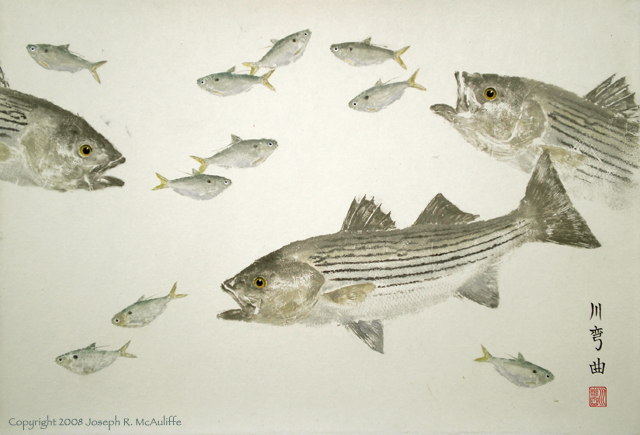
Striped bass slash through the edge of a school of baitfish. Large groups of these powerful, fast-swimming predators trap schools of their prey against the surface. The surface erupts into a churning feeding frenzy called a “striper boil” or “striper blitz.” The word blitz comes from the German word blitzkrieg (“lightning war”), coined in World War II to describe an attack conducted with great speed and force. Inside the boil, the ferocity of the attack stuns many of the small fish and they are then easily picked off. Fish-eating birds often join in the fray, snatching dazed fish foundering at the surface.
The striped bass (Morone saxatilis) is native to coastal waters of the eastern United States. Along the coasts of New Jersey, New York, Connecticut, Rhode Island, and Massachusetts in the fall, huge schools of stripers feed on concentrations of juvenile anchovies. Individual striper boils may contain hundreds of large, feeding fish.
In their native coastal habitat, striped bass spend their adult lives in saltwater, but enter rivers to spawn in the spring. Spawning fish release milt and roe near the water surface and the semi-buoyant eggs drift with the current before they hatch in two to three days. The young move downstream to estuaries by late summer or fall. Striped bass can also live their entire lives in freshwater and have been widely introduced to large reservoir impoundments throughout the United States and the rest of the world. For example, in the American Southwest, reservoirs on the lower Colorado River including Lake Havasu, Lake Mead, and Lake Powell all have populations of striped bass. Those populations spawn in flowing portions of the Colorado River above the reservoirs. The fish pictured here was caught in a water-supply canal (the Crosscut Canal) in Tempe Arizona, part of a canal sytem that receives water from the Colorado River through the Central Arizona Project (CAP) canal, constructed in the 1980s. In these lakes, one of the principal prey fish species is the threadfin shad (Dorosoma petenense), shown here. Schools of these small fish in freshwater lakes are subject to the same kind feeding frenzies of stripers as are anchovies in the Atlantic.
Size: 36 x 24 inches (2008)
Return to Gallery 2.